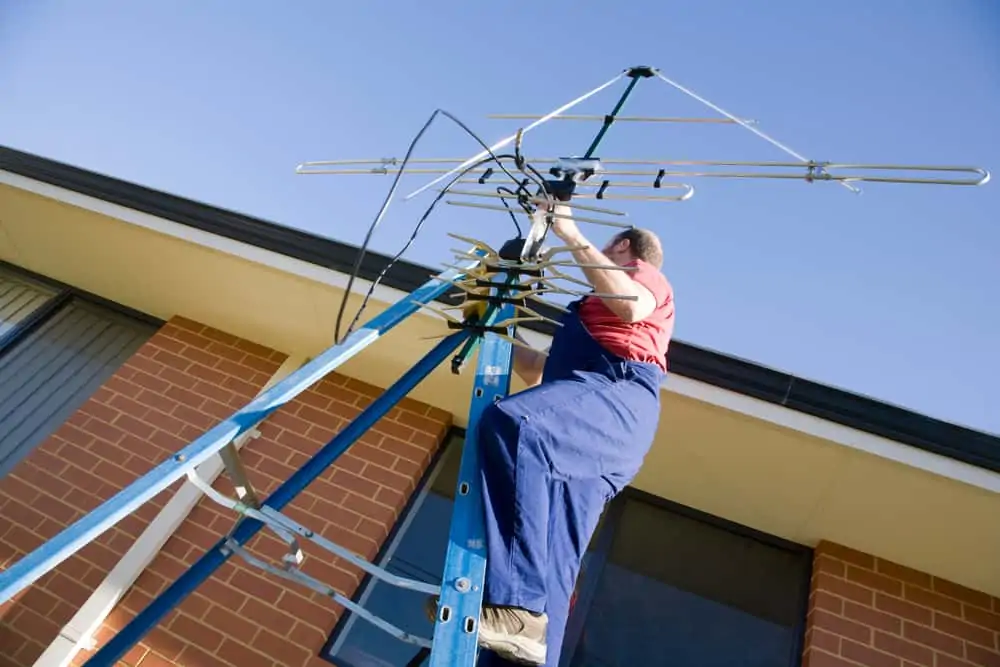Antenna installation safety matters because it protects both people and equipment. Falling, electrical shocks, and unstable mounts are common risks that can cause serious harm or property damage. Careless handling or ignoring safety rules may lead to costly repairs and injuries.
Taking time to plan and follow safe practices ensures every task is completed efficiently. Proper preparation, use of safety gear, and inspection at every step make installation smooth and secure. Safety awareness during antenna setup not only prevents accidents but also helps maintain signal quality and system performance for years to come.
Essential Safety Considerations for Antenna Installation
Staying safe during antenna setup involves several important precautions. Take a look at the most crucial considerations here:
Site and Weather
Inspect the area carefully before starting any work. Look for power lines, trees, or other obstructions that could interfere with the antenna. Avoid installing during rain, high winds, or storms, as wet or unstable conditions increase risks. Keep your workspace dry and stable, and choose a clear day to work. Taking a few minutes to evaluate surroundings can prevent serious accidents.
Gear and Tools
Use insulated gloves, helmets, and non-slip shoes to stay protected. Reliable tools like torque wrenches and voltage testers ensure precise, safe work. Always check your equipment for wear or defects before use. Sturdy gear and dependable tools reduce the chance of slips or shocks. Careful selection and inspection of your setup tools promote efficient, accident-free installation.
Electrical Safety
Keep the antenna and tools far from power lines to prevent electric hazards. Ground the system correctly to avoid current leaks or surges. Never work in wet areas or during lightning storms. Turn off nearby electrical sources when possible. Following safe electrical distance and grounding rules ensures you stay protected from unexpected shocks and short circuits.
Ladder and Roof
Place ladders on firm, level ground, and make sure they extend beyond the edge of the roof. Keep both feet balanced while climbing and avoid leaning too far. Use roof anchors or harnesses if the height is considerable. Avoid fragile or slippery roof surfaces that can cause falls. Secure footing is essential for preventing dangerous slips and injuries.
Checks and Help
Once the antenna is in place, inspect all bolts, brackets, and connections for tightness and balance. Look for frayed cables or bent mounts. Seek professional help if the system seems unstable or the location is hard to reach. Getting an expert opinion when unsure can save time, reduce risk, and improve antenna performance.
How to Prepare the Installation Site for a Safe Setup
Preparing the site reduces hazards and ensures a smoother workflow. To make your workspace safe, do that:
- Remove clutter, debris, or unstable objects from the installation area.
- Mark hazardous zones and ensure everyone nearby knows the boundaries.
- Identify potential electrical lines or cables under the surface.
- Keep your tools within reach to avoid stretching or unsteady movement.
- Create a stable path for carrying heavy parts to the site.
Essential Tools and Safety Gear for Antenna Installers
Safety gear and reliable tools protect workers from falls, shocks, and impact injuries. For a safe setup, review this list:
- Safety helmet
- Insulated gloves
- Non-slip boots
- Safety belt or full-body harness
- Voltage tester
- Adjustable wrench set
- Grounding wire
- Protective eyewear
- Ladder stabilizer
- Rope and pulley system
Safe Handling of Antenna Equipment and Components
Handling large antennas requires control and coordination to avoid accidents. Keep these in mind when following:
Lifting Techniques
Bend your knees and keep your back straight when lifting heavy parts. Avoid twisting your torso. If the antenna is large, lift with assistance instead of forcing it alone. Proper posture prevents strains and keeps the antenna steady during transport. Smooth, controlled lifting helps you stay balanced and reduces the risk of dropping components.
Team Coordination
Communicate clearly with your partners while moving or positioning the antenna. Assign specific roles, such as stabilizing, guiding, or fastening. Use clear signals or verbal cues to avoid confusion. Moving in sync ensures safe handling and prevents sudden jerks or slips. Teamwork minimizes errors and keeps everyone alert during installation.
Component Placement
Position mounts and cables before raising the antenna. Double-check that bolts and clamps are aligned. Keep all hardware organized to avoid searching mid-task. Supporting the structure at every stage keeps the system steady. Taking time to plan placement ensures smooth assembly and safe adjustments once the antenna is upright.
Aligning and Testing Antennas Safely
Adjusting and testing antennas demands precision and safety at once. Keep both hands steady and maintain a stable stance while fine-tuning the angle. Avoid overreaching or standing on unstable surfaces during alignment. Communicate with team members to confirm signal strength from a safe distance.
Use insulated tools for adjustments near electrical components. You can use free tools and guidance from Antenna Direction to make the alignment process easier and more precise while minimizing safety risks. Once alignment is done, test the reception carefully and secure all bolts to prevent movement during strong winds.
Importance of Post-Installation Safety Inspections
After installation, every connection, cable, and mount should be inspected to confirm stability and grounding quality. Loose fittings or poor seals can allow moisture to enter, causing corrosion or electrical faults.
Routine inspection after completion helps detect early signs of wear and mechanical stress. Fixing these issues promptly prevents collapse, maintains good signal performance, and ensures the system remains safe for years.
When to Call a Professional Antenna Installer
Hiring an expert is the smartest option when safety or equipment complexity feels overwhelming. Consider professional help in the situations below:
- When the roof height exceeds your safe working range.
- When strong electrical lines run near your installation site.
- When equipment requires specialized tools for mounting or grounding.
- When you lack help to lift and position heavy antennas safely.
Maintaining Long-Term Antenna Safety Through Regular Checks
Long-term safety depends on consistent inspection and prompt maintenance. Tighten loose bolts, clean corroded terminals, and check for weather-related damage. Look for cracks, leaks, or rust around joints. Replace worn parts before they cause breakdowns or performance loss.
During maintenance, consider using an antenna calculator to enhance performance and confirm your system continues operating efficiently. Small, regular adjustments extend lifespan, maintain safety, and prevent unexpected outages during storms or high winds.
Final Words
Safety in antenna installation never stops after the last bolt is tightened. Every new season, weather change, or upgrade brings new risks to manage. Keeping safety at the forefront ensures the system remains stable and effective for years. Simple habits, like inspecting, cleaning, and recording maintenance details, make a huge difference. Continuous caution and mindful actions protect both workers and property, securing every project’s success.


































